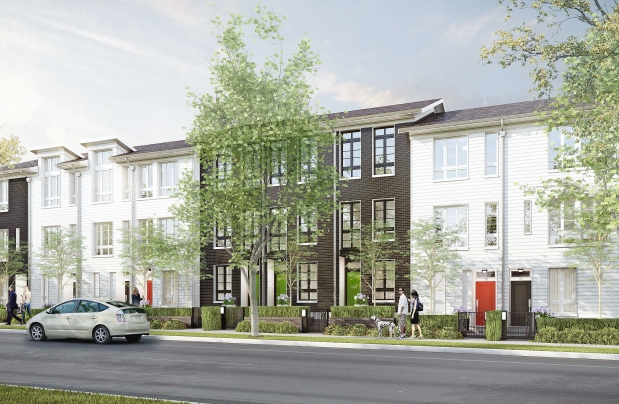ニュース
2.172015
バンクーバーウェストサイドのタウンハウス化が進んでいます。
バンクーバー・サン紙からの引用です。バンクーバーの主要な道路で良く見かける売り看板の列は、今後どんどんタウンハウスの建設が進みます。これらは一戸建てからサイズダウンする購買層や、ウェストサイドの環境や学区を重視するファーストタイムバイヤー層に人気で、今後も一層タウンハウス開発が進むと予想されます。個人的にはやはりウェストサイドは一戸建ての閑静な住宅街のままであって欲しいと思いますが、現在のバンクーバーの価格高騰や、住宅不足を考えるとこれも時代の流れと受け止めるしかなさそうです。
First-time homebuyers and downsizers love townhouses, but in Metro Vancouver’s urban areas they are few and far between.
The lack of townhouses could cause some single-family homeowners to stay in their houses longer than they would like and keep young people out of the market, experts say. To fill the gap, some developers are building larger condominiums, while others are focused on microsuites.
New townhouses on the market are snapped up quickly, but there is a perception that people don’t really want townhouse projects built in their neighbourhood, said Michael Ferreira, co-owner of Urban Analytics.
“In Dunbar or Point Grey … as soon as anybody brings a townhouse project on, it’s sold almost immediately regardless of the price,” Ferreira said. “It’s bit of a contradiction because there is this perception that there is resistance to that kind of density moving into these neighbourhoods, yet demand is obviously there.”
Jon Bennest, co-owner of Urban Analytics said he can count the number of new townhome projects in Metro Vancouver on his fingers. The shortage means young people delay purchasing a home until later in their lives, or move farther out into the suburbs, Bennest said. For downsizers, it means staying in their home longer or moving to an apartment.
Bennest said the main reason for the low numbers of townhouses being built is the lack of zoning for it. He said when land becomes available — such as at Olympic Village in Vancouver — it is usually zoned for mid-rise and low-rise condominiums with just a few townhouses at the bottom of the towers. Other land that comes up, like the Arbutus Ridge Theatre site, was already zoned for commercial use, so it is inappropriate for townhouses.
A solution would be for the city to pre-zone some designated parts of the city for townhouses, in areas throughout Metro Vancouver, Ferreira said.
“I think you could take a portion of just about any neighbourhood across the city and incorporate some townhomes,” Ferreira said. “It would be tough to do in downtown Vancouver, but I thing the Grandview-Woodland area would be good or even along the Cambie corridor, once you get off the main Cambie frontage.”
There will be a lot more townhouses in Vancouver in the future because the city recognizes it is an important and missing component of the housing market for both ownership and rental, said Brian Jackson, Vancouver’s general manager of planning and development services.
“We’re doing what we can through the planning process to find areas that we think are appropriate for townhouses,” Jackson said. “It provides the missing gap for people who don’t want to be in concrete highrises, who don’t want to be in on top of commercial or on arterials and who can’t afford a single family home.”
He said the new area plans in Marpole and Norquay included areas that were specifically set aside for townhouses, and that developers have been showing strong interest in those areas.
In the meantime, some developers in Vancouver are building larger condominiums, to serve as “stepping stones” either for downsizing homeowners who are not ready to move into care homes, but who no longer want a large single family home or for first-time homebuyers to break into the market.
“I think we’re hitting a tipping point where downsizers are reaching the age where they do want to get out of their single family home, but there isn’t much there,” Ferreira said. “We actually started to see it at Olympic Village, where the buyers were from the west side, Caucasian, and were moving out of their single-family homes and looking for the larger size units. That’s continued.
“A year ago on the Cambie corridor, you were seeing primarily newer Chinese families who had more recently immigrated who were buying the larger units, but it’s now transitioned to people from the neighbourhood who are selling their family homes.
“Sixteen hundred square feet on one level, lives pretty much the same as a 2,000-plus-square -foot multi-level home because you’re not wasting space with stairwells and modern design creates more efficient unit layouts.”
Barrett Sprowson, director of sales at Intracorp, has two projects that fit into that in-between category — the first is a condominium project called Livingstone House on the Cambie corridor that has larger-than-usual suites to attract west side downsizers and the second is a townhome project called Black and Whites in Coquitlam.
Intracorp’s Livingstone House on Cambie Street and 35th Avenue in Vancouver has some suites specifically designed to attract people who are downsizing from a house. Some of the suites are 1,200 or 1,300 square feet, but they are well laid out, so they function just as well as a larger house, Sprowson said.
“It actually lives a lot larger than its square footage would let on,” Sprowson said. “It’s very functional and very efficient.”
In Coquitlam at the Black and Whites townhouse project, Sprowson said buyers are either young families moving up or older families who are downsizing.
He says the demand has been “phenomenal,” including some people sleeping overnight to be first in line to buy a four-bedroom unit.
The townhouses, which are in an evolving area that is walking distance to transit’s new Evergreen Line, are three levels and between 1,237 and 1,675 square feet and have three or four bedrooms. Sprowson said they sell nearly as fast as they are released on the market, including 16 homes last weekend, of a total of 17 that were released onto the market.
“(For the young families), it gives them something they can live in today that makes sense and that they can grow into a little bit,” Sprowson said, adding that the older families who are buying into the project “can’t get their heads around living in an apartment — they don’t want the hassle of their single family home, but they don’t want someone living above them or below them.”
Sprowson said one reason there aren’t many townhouse complexes being built, despite their popularity, is that it is difficult to assemble the land.
“You need to be able to take three or four single-family homes and go through the rezoning process,” Sprowson said. “We did our first assembly in 2010 and that’s a long time ago and we’re only just coming to market now. It has been a long road, so it takes patience — as a developer you have to have your money sit there for a while and you have to have the capital to be able to do that.”
•
At the other end of the spectrum, Jon Stovell, president and CEO of Reliance Properties, has focused on building micro-lofts, which are very small suites — think 300 square feet — that come with large windows, higher ceilings, open plans and built in features like pocket walls and wall beds that are built in. They are built in urban areas, close to transit and shopping.
“The pent up demand for these other types of housing are really shocking and stunning,” Stovell said.
In a Victoria development on the waterfront, 100 microsuites sold in four weeks and 50 sold in one day, Stovell said.
“The Victoria real estate market was reeling because they thought it was a balanced or even a buyers’ market,” Stovell said, adding that a rental micro-loft project in Vancouver’s Downtown Eastside was rented out in one week.
The main buyers of the micro-suites are Millennials, or investors who want to rent to Millennials, Stovell said.
“The Millennials are the main cohort because they have a different attitude toward work-life balance,” Stovell said. “They’re more interested in spending less money on their homes and more on entertainment and travel. They’re very social so they see the city as their living room. ”
Micro-suite buildings tend to be built with lots of extra amenities like bookable dining rooms and communal outdoor or study areas, Stovell said.
He said that in Vancouver, the lower limit on suite size is 389 square feet, which prohibits the development of microsuites.
“It’s very sad. They’re keeping a lot of young people out of the market.”
Read more: http://www.vancouversun.com/business/affordability/Vancity+Housing+Affordability+Index+Townhouse+affects+entire+housing+market/10809374/story.html#ixzz3S1ijibpD
最近のニュース
-
2025/10/25
-
2025/5/28
-
2025/5/22
-
2025/5/22
-
2025/5/22
-
2023/1/6


























